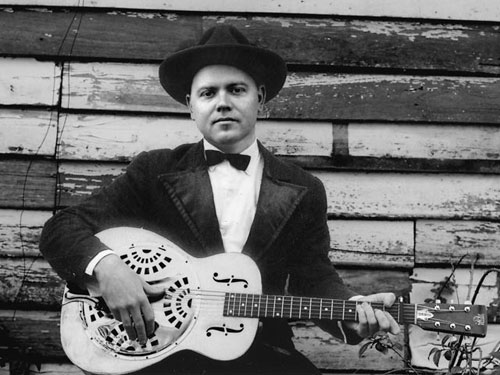CW Stoneking
November 29, 2008: Peter Dogherty
 In preparation for this interview I got hold of ‘King Hokum’, CW Stoneking’s 2005 album. I listened in awe but had no idea of where he came from; how old he was or where the music came from. The sound suggested an American recording by an mature singer or at least a singer with a voice from the Robert Johnson Blind Lemmon Jefferson era. Other questions were thrown up by the fact that the recording had a pre-war traditional sound, and it possessed a feel of the American South. Yet somehow, it was very much here and now. It took me back to the experience of listening to numerous blues singers, Jelly Roll Morton, King Oliver and others of that ilk.
In preparation for this interview I got hold of ‘King Hokum’, CW Stoneking’s 2005 album. I listened in awe but had no idea of where he came from; how old he was or where the music came from. The sound suggested an American recording by an mature singer or at least a singer with a voice from the Robert Johnson Blind Lemmon Jefferson era. Other questions were thrown up by the fact that the recording had a pre-war traditional sound, and it possessed a feel of the American South. Yet somehow, it was very much here and now. It took me back to the experience of listening to numerous blues singers, Jelly Roll Morton, King Oliver and others of that ilk.
Try as I may, I was never able to identify who he was copying till the penny dropped. He wasn’t copying anyone. ‘Jungle Blues’ CW Stoneking’s new album arrived and it became clearer. Having learnt and absorbed the forms of jazz, blues and other forms of hokum music, he is simply using them to tell his own stories, in his own unique musical way.
We met in an unassuming Brunswick house and sat in the sunny, unadorned backyard to chat. Dressed in his trademark pristine white trousers and shirt with his blonde hair brushed straight back, C.W. looks like a very young 34 year old. He answers to ‘C.W.’ and says that that’s how his mother addresses him. Retaining something of a southern accent from his American father, Stoneking has the relaxed manner of a Southern gentleman. A clear unblemished complexion shows no trace of the years of drinking and carousing alluded to on ‘Jungle Blues’. The story of the scientists and the boat trip described in the liner notes on the back of the album sleeve is basically true, but as a professional story teller he points out that he had to make it a little more interesting. The ship was actually a yacht and the fun and games aboard probably contributed to its demise off the coast of West Africa. Luckily the reefs helped C.W. survive but unfortunately two of his companions did not. That incident became the ‘Jungle Blues’ title track, as the tragic loss of musician friend Charley Bostock provided the story for ‘Charley Bostocks Blues’ on ‘King Hokum’. One of C.W.’s reasons for going to West Africa was to hear contemporary African music. One of his regrets is that he didn’t get to the area where Jimmy Rogers has long been considered something akin to a saint since a missionary introduced his music to the local population. When I pull him up on a lyrical inconsistency in ‘Talkin Lion Blues’ where he claims to hit the lion on the jaw, yet the lion complains of a black eye, he is unfazed. He thinks for a moment and responds “Maybe I hit him again when he was on the truck.”
Stoneking is rarely adamant about anything. He doesn’t attribute anything in particular as a direct influence or a starting point of the musical journey on which he is currently engaged. He concedes that his father who had played in R&B and pop bands some years earlier had sung to him when he was a child, but his was a very different musical trip. When quizzed on the wellspring of his unique creative skills as distinct from his musical skills, he points out that both his parents were writers. His father wrote poetry, film and TV material while his mother wrote poetry, children’s books and took photographs. He had a lot of stories read to him as a child. His mother, Patsy Marshall-Stace did the photography on both the albums and he confesses she is the only member of the team who didn’t get paid.
Living at Papunya where his father was a teacher he attended school and played exclusively with Aboriginal children till he was nine years old. He then moved to Sydney and began to teach himself to play electric guitar at eleven. By thirteen he was playing in a band but had still to discover the blues and switch to acoustic guitar. He lists Robert Johnson, Blind Blake, Willie McTell and Memphis Minnie among those he was listening to in his teens. He was on his way, but C.W. refers rather disparagingly to an early blues CD he made. He gives the impression that he had still not found what he wanted. Tiny Parham alerted him to Jungle Jazz while Jimmy Rogers, Billie Holliday and 1920s calypso music basically made up his full armory. He is fascinated by the whole singing, dancing, raconteur and double entrendre elements that make up the Hokum tradition. In his live performances he calls on the family storytelling skills to spin the truth into interesting background information.
In discussing the technical qualities of the album and the techniques used to achieve such a believable degree of historic verisimilitude C.W. is just as laid back and matter of fact. Firstly though he writes all the lyrics and music on the CD he does not actually read or write musical notation. He ‘writes’ the music in his head with the help of “mouth trombone”. When it comes to playing it with the rest of the band he tells them what he wants them to achieve and considers himself lucky that they are able to pick it up and get the desired result. Stoneking readily admits that it would be easier with charts. Charts would be handy when a new musician is introduced to the mix and has to be brought up to speed but C.W. shrugs his shoulders and says he doesn’t have time to learn to read music for the time being. The recording process carried out with help from recording engineer, J Walker all takes place in Adelphie Studio in Fitzroy. The studio is basically one large room with no booths. C.W. likens the process to recording a gig. It’s basically a straight studio recording. Just a room with no booms, but there were a couple of rhythm mics. They toughened up the bass a bit but didn’t find it necessary to play around with the sound to achieve an ‘old time’ effect. Once the music was recorded they dubbed the sound effects that had already been recorded in the field. He considers himself lucky to have musicians who can mostly double up on instruments because it saves quite a bit of money and organisation not having to hire so many.
When we get to talking about his instruments, he doesn’t feel so lucky. I asked what he was playing on the albums. It turns out that he was playing the Dobro pictured on the King Hokum sleeve and an old English tenor banjo. But he lost those in New York. They took off in the boot of a Yellow Cab and never came back. Now playing a National Tricone guitar and a Vega Tubaphone banjo, he is hoping to obtain a single cone National and is in two minds about the banjo. It was unreliable and he can’t forget his night in a sold out Hamer Hall when supporting Madeleine Peroux. The banjo broke just as he was coming to terms with playing an awesome venue in front of a very large audience. He called on his skills as a mouth trombone player to get out of a tight corner. I think I mentioned that he is a very relaxed dude.
www.myspace.com/cwstoneking


